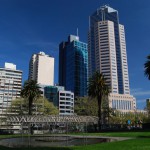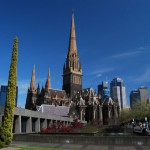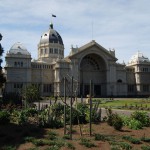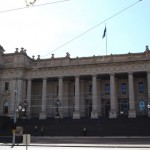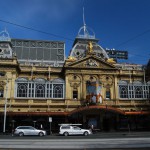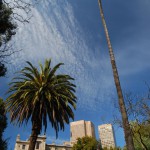Melbourne
After we examined the Blue MountainsNational Park, we headed for the capital of Australia – the city of Canberra. Having spent the night in Canberra, early in the morning we went on further. The next destination of our journey in Australia was the city of Melbourne. We heard a lot about Melbourne because of the culinary project of Jamie Oliver, who opened his restaurant Fifteen in Melbourne; as well as from the stories of my English friends from London, whose relatives live in Melbourne. Melbourne is different from Sydney; and by its rhythm of life, it is somewhat similar to London.
Melbourne is the second largest city in Australia, the capital of VictoriaState, which is spread out on the shores of PortPhilipBay. Its population with satellite cities is around 3.8 million people.
The city is one of the main commercial, industrial, and cultural centers of Australia. Melbourne is also called the country’s capital of sports and culture, since many sports and culture events in the life of Australia are held here. The city is famous for its combination of Victorian and modern architecture, numerous parks and gardens, multifaceted and multi-national population. In 1956, Melbourne hosted Summer Olympics, and in 2006 – the Commonwealth Games. Here in 1981, was held a summit of the heads of the British Commonwealth States, and in 2006 – a summit of G20, attended by the heads of nineteen most developed and powerful nations of the world.
The territory around the Yarra River and Port Philip Bay, on which Melbourne currently lies, before the arrival of Europeans was inhabited by representatives of the Australian indigenous people’s tribe Wurundjeri. It is commonly thought that the aborigines lived in this area for at least 40 000 years. The first attempt to found a European colony here, was made by the English in 1803, when they built a settlement for convicted criminals in the area of SullivanBay, but this settlement was abandoned shortly, in just a few months.
In May and June of 1835, the territory, which is now occupied by the central and northern parts of the city, was surveyed by John Batman, one of the founders of Port Philip, who made a treaty with eight chiefs of the Wurundjeri tribe to purchase 600,000 acres (2,400 square kilometers) of the neighbouring lands. He chose the Yarra’s north bank for the settlement and declared, that “upon this place a village will be built,” after which he returned to Launceston city in Tasmania, which was called then Van-Diemen’s Land. But when the settlers sent by the Association finally arrived to build the village, they found out that there already had been a settlement formed by a group of people led by John Pascoe
Fawkner, who arrived here on board of a ship Enterprise on August 30, 1835. Eventually, both groups came to an agreement to develop the territory together. The treaty, signed by Batman with the aborigines, was soon annulled by the administration of New South Wales which ruled at that time over the territory of the entire mainland Australia. It meant that the land was transferred under the ownership of the Crown, but the rights of the people who lived here were confirmed, and the newly formed city was granted legal acknowledgement.
In 1836, Governor Burk declared the city the administrative capital of the Port Phillip District of New South Wales, and commissioned the first plan for the city, known as the Hoddle Grid, in 1837. Later that year the settlement was given its final name – “Melbourne” after the British Prime Minister, William Lamb, 2nd Viscount Melbourne, whose seat was Melbourne Hall in the market town of Melbourne, Derbyshire. Melbourne was declared a city by letters patent of Queen Victoria, issued on 25 June 1847.
When VictoriaState received the status of an independent colony in 1851, Melbourne became its capital. The discovery of gold in Victoria in 1851 led to the Victorian gold rush, and Melbourne, which served as the major port and provided most services for the region, experienced rapid growth. During the city’s rapid growth in the 1850-s and 1860s, many well known buildings were constructed in Melbourne, such as: Victoria’s Parliament House, the Treasury Building, the State Library, the Supreme Court, the University, General Post Office, Government House, as well as St Paul’s and St Patrick’s Cathedrals. The city’s inner suburbs were well-planned; numerous boulevards were made, and gardens and parks were laid in the city. During these years, Melbourne had become the country’s major financial center: headquarters of several large banks were opened in it. In 1861, the first Australian stock market was founded in the city.
The economic boom of the Victorian gold rush peaked during the 1880s, by which time Melbourne had become the richest city in the world, and the largest after London in the British Empire. Melbourne hosted two international exhibitions at the large purpose-built Exhibition Building between 1880 and 1890. During a visit in 1885 English journalist George Augustus Henry Sala coined the phrase “Marvelous Melbourne”, which stuck long into the twentieth century and is still used today by Melburnians. Growing building activity culminated in a “land boom” which, in 1888, reached a peak of speculative development fuelled by consumer confidence and escalating land value. As a result of the boom, large commercial buildings, coffee palaces, terrace housing and palatial mansions proliferated in the city. Not all of them survived in the wake of the following development of the city, when modern high-rises were built, and after many constructions of that epoch were demolished due to the toughening of fire safety requirements. Nevertheless, Melbourne is still famous for its Victorian architecture. This period also saw the expansion of public transportation system, and, in particular, a major radial rail-based transport network.
A brash boosterism that had typified Melbourne during this time ended in 1891 with a severe depression of the city’s economy, sending the local finance and property industries into a period of chaos. The Melbourne financial crisis was a contributing factor in the Australian economic depression of the 1890s and the Australian banking crisis of 1893. The effects of the depression on the city were profound, although it recovered enough to grow slowly during the early twentieth.
At the time of Australia’s federation on 1 January 1901, Melbourne became the seat of government of the federation. The first federal parliament was convened on 9 May 1901 in the Royal Exhibition Building, subsequently moving to the Victorian Parliament House where it was located until 1927, when it was moved to Canberra. The Governor-General of Australia resided at Government House in Melbourne until 1930 and many major national institutions remained in Melbourne well into the twentieth.
The city was also the headquarters of the Allied forces under the command of American General Douglas McArthur in the Pacific theater during the Second World War between 1942 and 1944. During the war period, Melbourne industry received numerous military orders, which turned the city into one of the Australia’s major industrial centers. After the war, the city continued to grow rapidly because of the post-war immigration boom, and also because of the city’s boosted prestige as the organizer of summer Olympic Games in 1956. In the following decades the road network was actively developing, and the significant increase of the number of personal vehicles allowed to develop the city’s neighbouring suburbs. Melbourne’s central districts were refashioned and renewed when numerous projects modernizing the city’s infrastructure were carried out. Australia’s financial and mining booms between 1969 and 1970 had a favourable effect on the city. The headquarters of many major companies were moved to Melbourne, including the Australian Reserve Bank. The city remained the Australia’s financial and business capital until late 1970s, after which, it started to gradually yield its leading positions to Sydney.
Melbourne’s economy greatly suffered during an economic recession in VictoriaState between 1989 and 1992. In this period many economy institutions of the city ceased to exist. In 1992, a government coalition headed up by Jeff Kenneth came to power. The new administration started a campaign to renovate the city’s economy, numerous investment projects were commenced, and the authorities began a campaign to develop Melbourne as a tourist center. A number of famous world festivals and events were held in the city, such as the Grand Prix of Formula 1 racing. Major projects of that time were the reconstruction and building works at MelbourneMuseum, Federation Square, Melbourne Exhibition and Convention Center, Crown Casino, and City-Link (pay-highway, running across the city’s center). Along with that, some Melbourne infrastructure objects were privatized, including power supply and public transport systems, and principles of financing were changed in many social spheres, including the health care and education systems.
Beginning from 1997, there was a significant increase in population and job vacancies in Melbourne. Significant international investments are made into the development of the city, mainly into industry and real estate market.
According to the Australia’s Bureau of Statistics, from 2000 Melbourne is holding the first place in Australia in figures of economic growth and increase of the population.
Modern Melbourne is a multi-national and multi-cultural community. Almost a quarter of Victoria State population are people, who were born outside Australia; and Melbourne is a home for immigrants from 233 countries, who speak 180 languages and confess 116 different religions.

